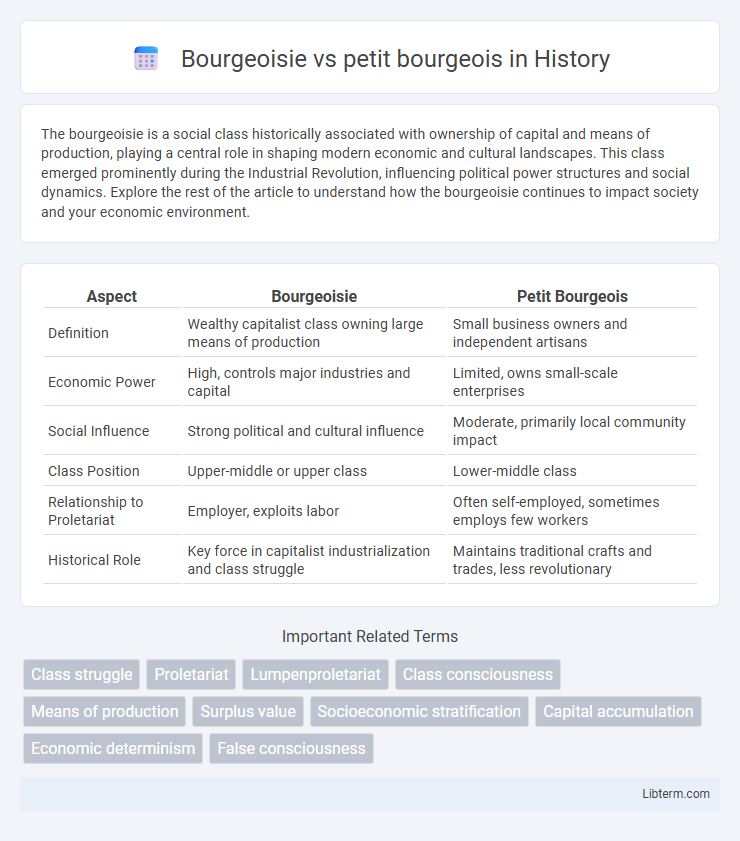The bourgeoisie is a social class historically associated with ownership of capital and means of production, playing a central role in shaping modern economic and cultural landscapes. This class emerged prominently during the Industrial Revolution, influencing political power structures and social dynamics. Explore the rest of the article to understand how the bourgeoisie continues to impact society and your economic environment.
Table of Comparison
| Aspect | Bourgeoisie | Petit Bourgeois |
|---|---|---|
| Definition | Wealthy capitalist class owning large means of production | Small business owners and independent artisans |
| Economic Power | High, controls major industries and capital | Limited, owns small-scale enterprises |
| Social Influence | Strong political and cultural influence | Moderate, primarily local community impact |
| Class Position | Upper-middle or upper class | Lower-middle class |
| Relationship to Proletariat | Employer, exploits labor | Often self-employed, sometimes employs few workers |
| Historical Role | Key force in capitalist industrialization and class struggle | Maintains traditional crafts and trades, less revolutionary |
Introduction to Bourgeoisie and Petit Bourgeois
The bourgeoisie refers to the capitalist class that owns the means of production and wields significant economic power in society. The petit bourgeois, or small bourgeoisie, consists of small business owners, artisans, and independent professionals who occupy a middle position between the working class and the bourgeoisie. Understanding the distinction between these two groups is essential for analyzing social dynamics, class relations, and economic structures within capitalist economies.
Historical Origins of Class Distinctions
The bourgeoisie emerged during the late Middle Ages as wealthy merchants and industrial capitalists who gained economic power through trade and factory ownership, fundamentally shaping modern capitalism's development. In contrast, the petit bourgeoisie consisted of small business owners, artisans, and independent professionals who occupied a middle position between the working class and the bourgeoisie, often struggling to maintain their economic independence amid industrialization. These class distinctions have roots in feudal societies where social stratification based on land ownership gave way to new economic divisions driven by commerce and industrial production.
Defining the Bourgeoisie
The bourgeoisie refers to the social class that owns the means of production and holds significant economic power, typically encompassing capitalists and industrialists. They contrast with the petit bourgeois, who are small-scale business owners or artisans with limited capital and influence. Defining the bourgeoisie involves recognizing their dominant role in shaping market economies and controlling wealth generation.
Who Are the Petit Bourgeois?
Petit bourgeois, often referred to as the lower middle class, typically includes small business owners, shopkeepers, and independent professionals who own means of production but do not employ large numbers of workers. Unlike the bourgeoisie, who hold significant capital and control major industries, the petit bourgeois maintain limited economic power and often face precarity in market competition. This social class bridges the gap between the working class and the dominant capitalist class, influencing economic dynamics and class relations.
Economic Roles and Interests
The bourgeoisie primarily controls large-scale capital and industrial enterprises, driving economic growth through investment, production, and market expansion, emphasizing profit maximization and capital accumulation. In contrast, the petit bourgeois consists of small business owners, artisans, and shopkeepers who focus on maintaining independent operations and local market stability, often prioritizing self-sufficiency and direct consumer relationships. Their economic interests differ as the bourgeoisie seeks systemic market influence and scale economies, while the petit bourgeois emphasizes preserving autonomy and resisting corporate domination.
Sociopolitical Influence of Each Class
The bourgeoisie wields substantial sociopolitical influence by controlling capital, setting economic agendas, and shaping policy through ownership of major industries and media outlets. In contrast, the petit bourgeois, composed of small business owners and professionals, exercises localized influence primarily within community institutions and trade associations but lacks the expansive political power of the bourgeoisie. The divergent roles of these classes underscore the stratified nature of power distribution in capitalist societies, where the bourgeoisie actively drives systemic change while the petit bourgeois tends to maintain social stability.
Cultural Differences and Lifestyles
The bourgeoisie typically exhibit cosmopolitan cultural tastes, prioritizing high art, classical music, and international travel, reflecting their economic power and global outlook. In contrast, the petit bourgeois often maintain traditional, localized cultural values, favoring community-based activities, family-oriented lifestyles, and practical concerns over luxury or elite status. These cultural differences underscore distinctions in social identity, consumption patterns, and lifestyle aspirations between the two classes.
Conflict and Cooperation between Classes
Conflict between the bourgeoisie and petit bourgeois arises from their differing economic interests and social status, with the bourgeoisie controlling large-scale capital and means of production while the petit bourgeois struggles to maintain small businesses and independent livelihoods. Cooperation occurs when both classes align against the proletariat to protect property rights and resist labor organization, despite underlying tensions over economic dominance. This dynamic tension shapes class relations, influencing political alliances and economic policies within capitalist societies.
Relevance in Contemporary Society
The bourgeoisie, characterized by ownership of large-scale capital and industry, contrasts with the petit bourgeois, who typically manage small businesses or fractional ownership, shaping distinct economic behaviors and class interests in contemporary society. Their relevance is evident in urban economic stratification, consumer culture, and political influence, where the bourgeoisie drive globalization and major market trends while the petit bourgeois preserve local commerce and entrepreneurial diversity. This dynamic underscores ongoing debates on social mobility, wealth distribution, and economic resilience amid technological and globalization pressures.
Conclusion: Ongoing Class Dynamics
The ongoing class dynamics between the bourgeoisie and petit bourgeois continue to shape socioeconomic structures, with the bourgeoisie maintaining dominant capital ownership and influence over production. The petit bourgeois face increasing challenges due to market pressures and limited resources, often struggling to sustain their independent economic positions. This persistent tension highlights the evolving nature of class relations and the impact on social mobility and economic inequality.
Bourgeoisie Infographic

 libterm.com
libterm.com